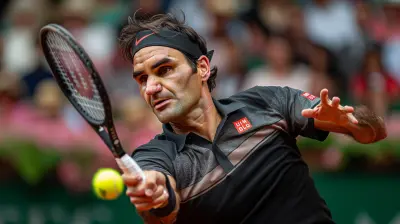The Evolution of Tennis Sponsorships and Endorsements
30 May 2025
Tennis, a sport known for its grace, power, and global appeal, has come a long way—not just in gameplay but in the business behind it. One of the biggest transformations? Sponsorships and endorsements. From wooden rackets and modest prize purses to multi-million-dollar deals with luxury brands, tennis has embraced corporate partnerships like never before.
But how did we get here? How did tennis legends transition from simple gear endorsements to securing lifestyle deals with global brands? Buckle up because we’re about to dive deep into the fascinating evolution of tennis sponsorships and endorsements! 
Early Days: A Modest Beginning
Before the dazzling logos on player outfits and high-profile shoe deals, tennis was more of a gentleman’s game played in crisp white attire. Back in the early 20th century, sponsorships were practically non-existent. Amateur players focused purely on winning, and commercial influence was minimal.One of the few early sponsorships came from equipment manufacturers. Players would receive rackets and shoes from brands in exchange for using them on the court. There were no flashy advertisements—just a handshake and hope that people noticed.
Even the prize money was modest. Players relied on club memberships and coaching gigs to earn a living. Professional tennis had yet to take off commercially, and corporate sponsorships didn’t have a significant place in the sport. 
The 1960s and 1970s: The Open Era and The Rise of Sponsorship
Everything changed in 1968 with the dawn of the Open Era. For the first time, amateur and professional players could compete together, and prize money skyrocketed. This also opened the floodgates for sponsorship deals.During this period, iconic brands such as Wilson, Fila, and Lacoste became some of the first companies to sign endorsement deals with top players. Björn Borg, with his cool demeanor and signature headband, became a marketing dream. Companies weren’t just selling tennis equipment anymore; they were selling a lifestyle.
By the time the 1970s rolled around, sponsorships were no longer just about rackets. Clothing brands saw the potential in tennis, and soon, stylish outfits emblazoned with logos started making their way onto the court. It was the beginning of tennis fashion as we know it today. 
The 1980s and 1990s: The Golden Age of Endorsements
If the ‘70s laid the foundation for sponsorship deals, the 1980s and 1990s took them to another level. Tennis became one of the most marketable sports in the world, thanks to the likes of John McEnroe, Steffi Graf, Andre Agassi, and Pete Sampras.Agassi, in particular, changed the game. With his flashy, rebellious attitude and colorful Nike outfits, he made tennis cool. His partnership with Nike became legendary, proving that players could be more than just athletes—they could be global fashion icons.
Meanwhile, racket manufacturers were locked in fierce competition. Brands like Wilson, Head, and Prince aggressively pursued top players, ensuring their equipment had prime visibility during matches broadcasted to millions.
The prize money was growing, but endorsements were becoming even more lucrative. By the late ‘90s, some players were earning more from sponsorships than tournament winnings. Tennis had firmly established itself as a commercial powerhouse. 
The 2000s: The Federer-Nadal Era and Global Expansion
Enter Roger Federer and Rafael Nadal—the faces of modern tennis dominance. Their rivalry wasn’t just about epic five-setters; it was also about who could land the bigger endorsement deals.Federer, with his smooth playing style and gentlemanly image, became a magnet for luxury brands. Rolex, Mercedes-Benz, and Uniqlo all lined up to sign him. His deal with Nike alone was worth millions before he moved on to Uniqlo in a staggering $300 million agreement.
Meanwhile, Nadal, the fiery warrior from Spain, became the face of Nike’s tennis line. His sleeveless tops and pirate-style bandanas made him an instant marketing sensation. Alongside Nike, he struck deals with Babolat, Kia, and Richard Mille, among others.
During this era, sponsorships stretched beyond just sportswear and equipment. Players became ambassadors for everything from watches to airlines. Tennis had transcended sports—it was now a billion-dollar branding machine.
Today’s Era: Multi-Platform Branding and Mega Deals
Fast forward to today, and tennis endorsements have gone beyond just TV commercials and magazine ads. With the rise of social media, players now have huge followings on Instagram, Twitter, and TikTok, making them even more valuable to brands.Take Naomi Osaka, for example. She’s not only a tennis champion but also a voice for social change. Her endorsements with Nike, Louis Vuitton, and Tag Heuer show how modern athletes are expected to be more than just players—they are influencers, role models, and global icons.
Similarly, Serena Williams has built an empire beyond tennis, landing deals with Gatorade, Beats by Dre, and even launching her own fashion line. The modern tennis star is not just an athlete but a business mogul.
With prize money still growing but sponsorship deals reaching astronomical levels, many young players now focus on building their brand from the start. Coco Gauff, Carlos Alcaraz, and Jannik Sinner are already securing major endorsements despite being early in their careers.
The Future: Where Do Tennis Sponsorships Go Next?
So, what’s next? If current trends are anything to go by, sponsorships in tennis will only continue to evolve. Here are a few things to watch out for:1. Tech and AI Integration
Companies like Apple, Samsung, and Google could start integrating AI-driven performance tracking in sponsorship deals. Imagine players wearing smart clothing that provides real-time data on their performance—branded, of course.2. Streaming and Digital Partnerships
With streaming platforms dominating entertainment, expect more partnerships with Netflix, Amazon Prime, and YouTube. Behind-the-scenes documentaries and exclusive content deals could become major money-makers.3. Personal Branding & Entrepreneurship
Tennis players are becoming more business-savvy. Expect more self-branded ventures—whether in fashion, health, or even NFTs (Non-Fungible Tokens).4. Sustainability Sponsorships
As the world shifts towards eco-friendly products, brands focusing on sustainability (like Adidas with its recycled materials) will likely dominate tennis endorsements. Players who champion such causes will attract significant deals.Conclusion
Tennis sponsorships and endorsements have evolved dramatically over the years. What started as simple equipment deals has turned into a multi-billion-dollar industry where athletes are not just players but global icons.From the early days of wooden rackets to today’s high-fashion tennis outfits, the sport has seamlessly blended athleticism with business. And with social media, technology, and new markets emerging, the future of tennis sponsorships looks brighter than ever.
So, the next time you see a player rocking a stylish outfit or lifting a trophy with a brand’s logo in the background, just remember—it’s not just about winning titles anymore; it’s about making history, both on and off the court.
all images in this post were generated using AI tools
Category:
TennisAuthor:

Umberto Flores
Discussion
rate this article
4 comments
Jude Henderson
Tennis sponsorships and endorsements have transformed from basic brand partnerships into multifaceted collaborations, driving players' financial security and elevating the sport's global reach. As athletes embrace their influence, the dynamic landscape reflects broader trends in sports marketing and consumer engagement.
June 22, 2025 at 11:40 AM

Umberto Flores
Thank you for your insightful comment! I completely agree that the evolution of tennis sponsorships reflects broader trends in sports marketing, enhancing both player financial security and the sport's global appeal.
Tala Mercado
Tennis sponsorships have come a long way—like a lob shot that defies gravity! From wooden rackets to flashy sneakers, it's a wild ride of logos and cash. Who knew the real match point would be between brands fighting for court time? Let the endorsements ace it out! 🏆🎾
June 5, 2025 at 11:18 AM

Umberto Flores
Thanks for your engaging comment! The evolution of tennis sponsorships truly reflects the sport's dynamic growth and the increasing influence of branding—it's a fascinating match that continues to evolve! 🎾
Tamara McKee
This article highlights the transformative role of sponsorships in tennis, showcasing how partnerships with brands have influenced athlete careers and the sport's global reach. A fascinating insight into the game's commercial evolution!
June 1, 2025 at 10:57 AM

Umberto Flores
Thank you for your insightful comment! I'm glad you found the article engaging and reflective of tennis's commercial evolution.
Rylan McClure
Tennis sponsorships have transformed the sport, amplifying player visibility and shaping the game's marketability. This evolution reflects a dynamic relationship between athletes and brands, driving innovation and fan engagement.
June 1, 2025 at 3:47 AM

Umberto Flores
Thank you for your insightful comment! Indeed, the synergy between sponsorships and tennis has significantly elevated both player profiles and the sport's overall appeal.



